When light lifting equipment is required in the workplace, there are many ways to get the job done while meeting your goals. When you determine that adding a ceiling mounted or freestanding workstation crane or monorail is the answer, working with an experienced crane manufacturer and dealer is one key to success. Light lifting means lifting loads you may normally manually lift, or loads up to 2 tons. There are many different crane options out there to meet your needs no matter where you fall in this spectrum.
Ergonomic lifting is a key concern with any lifting whether you are using manual lifting processes or lifting with a device. If lifting requires awkward postures, repetitive motions, forceful exertions or static postures, there is a risk of musculoskeletal disorders (MSDs) for those who perform manual material handling tasks. Similar risks come into play when workers are using equipment to lift loads, like cranes, because elements like the pendant height must be adjusted so every worker can use the equipment ergonomically. Safety of your workforce should always be a top priority.
Meeting both your ergonomic and performance goals with a crane is possible. In this article, we will go through options available for lifting light loads with an overhead crane. These types of cranes can be configured to meet your performance needs while replacing manual lifting and manual material handling.
Equipment Options for Lifting Light Loads
Jib Cranes
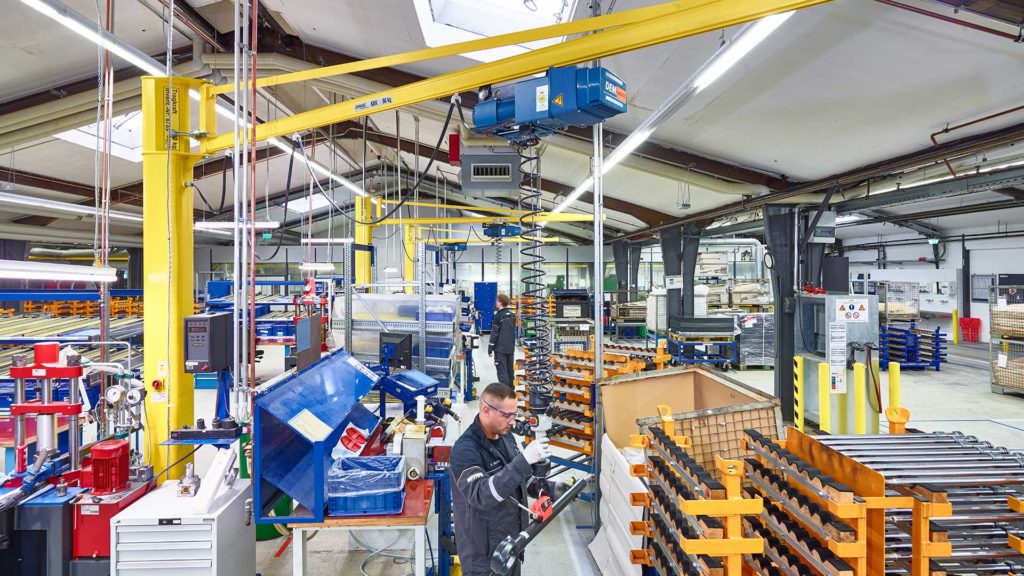
Jib cranes are ideal when the lifting process can replace manual lifting in a focused area. They help optimize part of a production process or flow to be more efficient. Jib cranes are mounted to a wall, building column or can be mounted to a freestanding pillar. The jib boom, or arm, can service a semi-circle area, with the circumference dependent on the length of the jib boom. The force required to rotate the jib boom increases as you position the load closer to the pivot point of the jib boom. If you want to rotate a jib manually, locate the jib in your workcell so the load, typically, is rotated in the outer 2/3s of the boom length. The type of jib arm used on the crane is based on many factors including lifting capacity. If a heavier load is required, an I-beam can be used, whereas with a lighter load, a steel or aluminum enclosed rail track can be used. Electric motorized rotation is an option for high capacity (such as a 2 Ton capacity) jib cranes that are used frequently.
Jib cranes attached to the wall or to a building column with a bracket can be an economical and easy way to install a crane into an area requiring light lifting. Similar to how a door swings open, a jib crane attached to the wall can service a large area without losing floor space. The suitability of the wall or building column to support the loads imposed by the jib crane must be checked to ensure a safe and secure installation. The crane manufacturer and dealer will provide the forces needed to make this determination.
If there is no place to attach the crane to the building structure, a pillar can be installed into the floor. Because it is not dependent on the available building structure, a jib crane mounted on a pillar can be placed nearly anywhere within a building. In many cases, pillar mounted jibs can be chemically anchored to an existing concrete floor, provided the concrete meets certain specifications and can withstand the forces supplied by the crane manufacturer and dealer. In cases where the concrete does not meet these specifications, a foundation with embedded anchors can be added to support the pillar.
There are many different types of devices that can be attached to jib cranes to make lifting ergonomic. Hoists are one of the most common used on jib cranes. Electric chain hoists are extremely cost effective and compliment a wide variety of lifting needs. Many hoists can be outfitted with additional attachments to pick up nearly anything effectively and efficiently. When a jib crane is installed over an assembly process, electric balancers and air balancers are options that give operators in the area additional ergonomic ways to maneuver a load and can help improve existing processes.
Workstation Crane and Monorail Systems
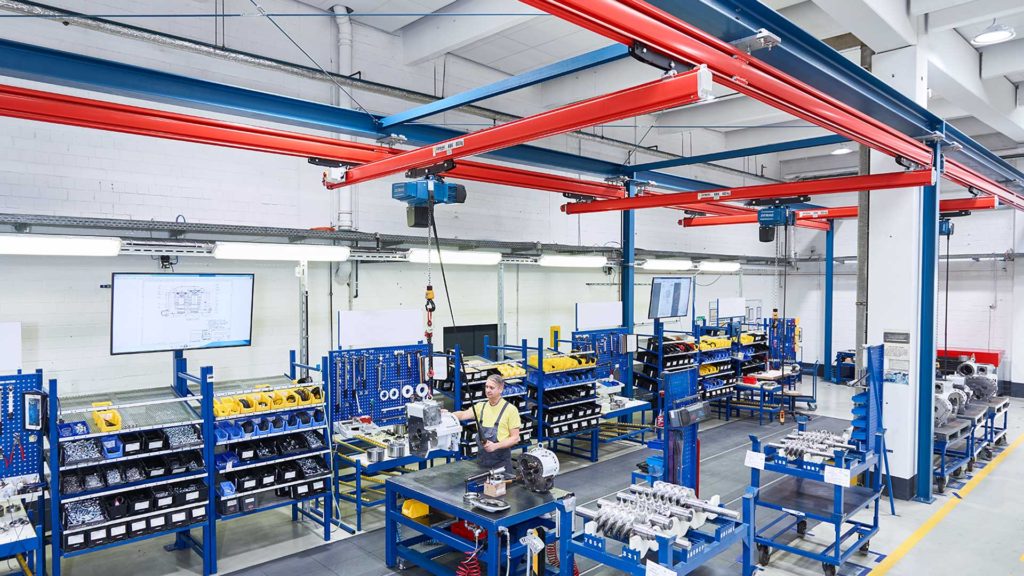
When you need a crane to help with material flow and ergonomic lifting, an enclosed track workstation crane system can assist. This type of crane system is focused around lighter lifting, in most cases up to 2 tons, and compliments the process flow through a production or manufacturing area. These systems typically use enclosed rail sections. The enclosed track can be made of steel or aluminum. Aluminum track profile is the most ergonomic option due to physical weight of the track and the very low rolling resistance. Steel tracks have higher capacities and can span longer distances while offering very low rolling resistance. The systems can be as simple or complex as the area requires, including the addition of multiple bridges or branching components like interlocks, track switches, and turntables. Manual or motorized operation is possible and semi or full automation can be implemented or retrofitted at a later date.
Like any crane, there are many different devices that can be attached to the rail to assist with ergonomic lifting within an area. These devices can be an off-the-shelf solution like a chain hoist or balancer, or solutions can be custom designed devices, like arms and grippers, to meet nearly any need you have. Electric chain hoists are flexible workhorses that compliment a variety of processes. When a device like grippers or tongs are added, a simple chain hoist becomes a solution tailored to your exact needs. Air balancers and electric balancers compliment assembly processes for the area and make maneuvering a load simple and ergonomic.
Ceiling Suspended Enclosed Track Crane Systems
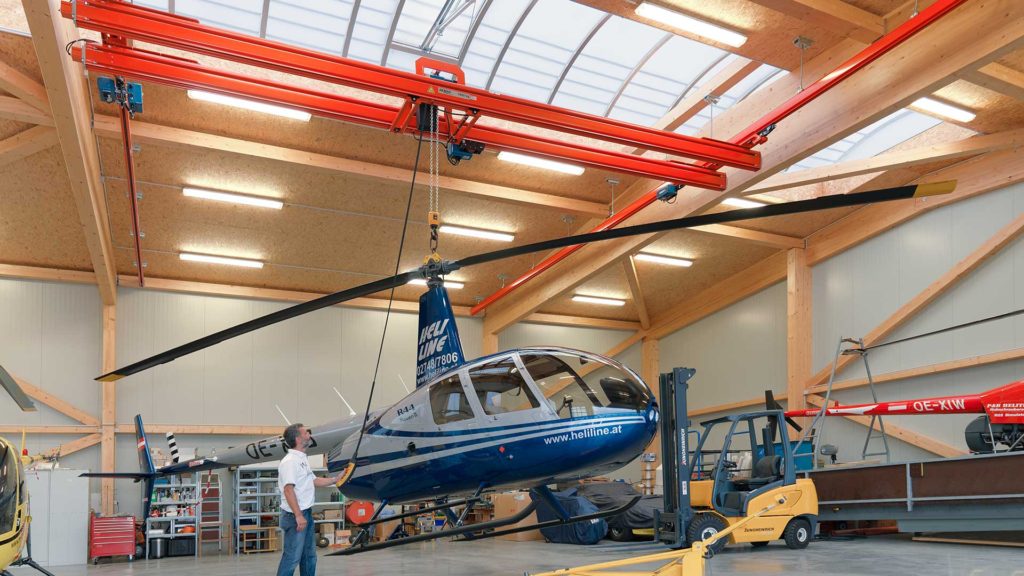
An advantage of a ceiling suspended enclosed track crane system is that it does not take up any valuable floor space, unlike a freestanding system that requires additional floor mounted columns to support the crane. The crane manufacturer or dealer can provide the maximum weights and loads imposed by the crane system so the ceiling structure can be checked.
Freestanding Workstation Cranes and Monorails
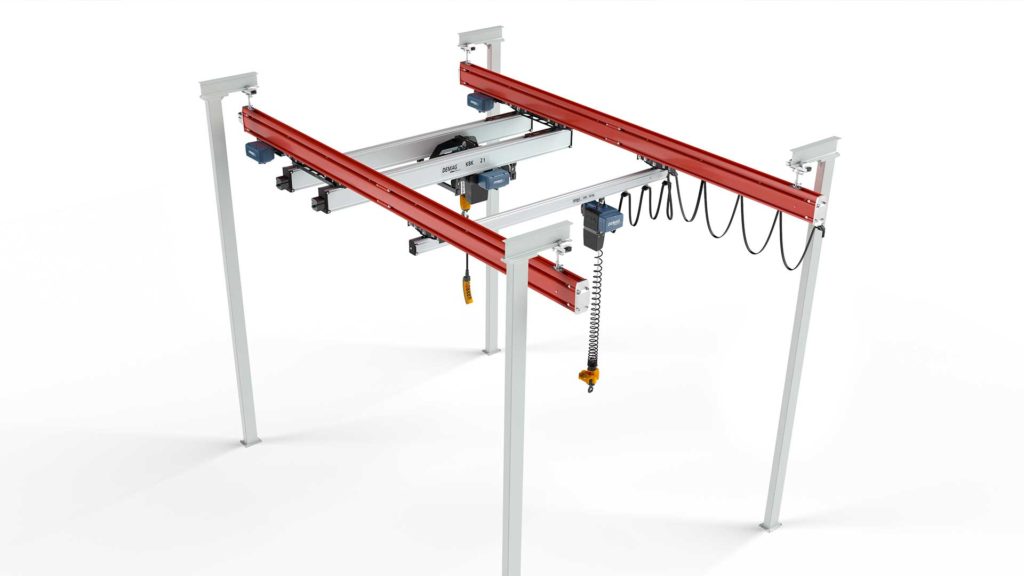
Similar to an enclosed track crane system, a freestanding workstation crane gives you the ability to drop light lifting capabilities into an area with existing processes. Because it is not dependent on being mounted to the ceiling or needing the support any other structural steel, systems can be strategically placed into existing processes and around machinery. Freestanding workstation cranes typically use enclosed rail track made of steel or aluminum. The most ergonomic option is typically aluminum because it is a lighter weight material and has a lower rolling resistance than steel. These factors make it easier to move the load on an aluminum track. Both types of rail allow operators to lift ergonomically with the help of hoists or balancers, and can improve the flow of material through the area.
There are 3 types of freestanding structures to consider based on your needs. First is the standard freestanding workstation. This structure has posts evenly placed on both sides to support the system. This type of structure has less flexibility than other configurations, but it is a common way to configure a workstation to meet many needs.
Second is a structure where the rail is attached to a post in a lamppost style. This is one of the most flexible configurations. Depending on the system and your requirements, the posts don’t need to be evenly placed so this configuration can be designed to work around existing machinery and building elements.
Last is the cantilever configuration. This type of structure is made up of multiple posts with overhanging supports from which both runways and the bridges are suspended. The cantilever option is the most flexible when various types of machinery need to be brought into the area because the design of the structure has one completely open side. Many times, we see that assembly areas require additional machinery to help with processes within the area. Cantilever configured freestanding workstation cranes are optimal for these areas because there are no obstructions on one side, which makes bringing tow motors and pallet jacks into the area safer and more efficient.
Gantry Cranes
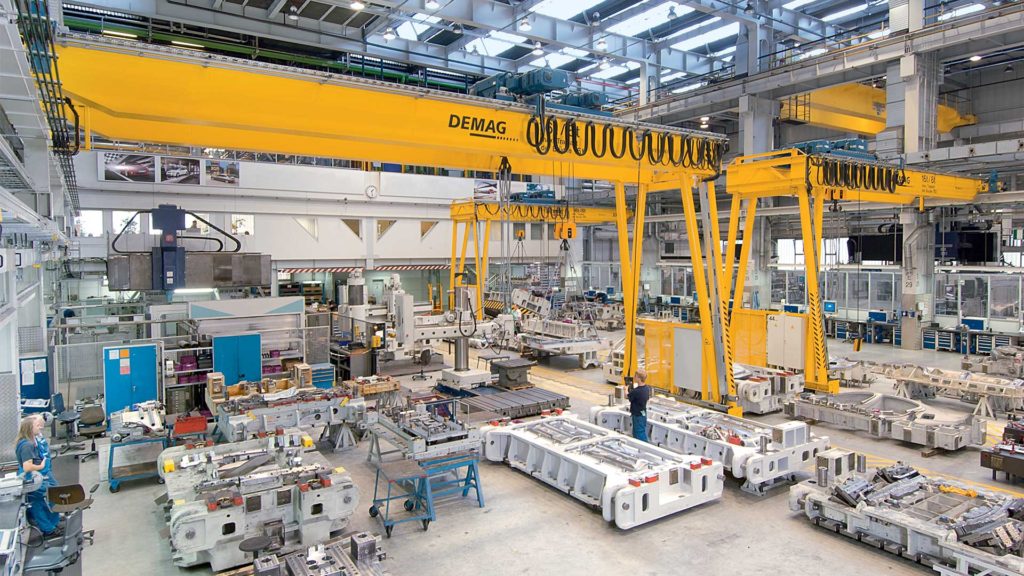
There are many different types of gantry cranes out there. Gantry cranes for light lifting applications are a type of portable crane unit and can also be referred to as portal cranes. Gantries for light lifting consist of 2 freestanding posts that are on wheels and support an enclosed track monorail and chain hoist. These systems can be pushed over a smooth floor to an area where lifting is required.
A gantry crane for heavy lifting will nearly always run on a track on the floor rather than set up as a portable crane. They will not be able to be moved manually, both due to the load being lifted and the weight of the physical configuration of the crane. These cranes always have controls, like a remote, to help with lifting and moving loads.
Gantry cranes can be full or half gantry. When looking at a gantry for heavy lifting, a full gantry, or portal, crane will run on 2 tracks in the floor or ground. The crane could be outside or run inside a shop to assist with the necessary processes. When a half gantry is needed, the crane is configured so one side of the bridge moves on the runway attached to the building while the opposite side will be mounted to a leg that runs on wheels on the floor.
It doesn’t matter how heavy the load or complicated your material handling process is today. When you are lifting 2 tons and smaller loads, it’s important that lifting be ergonomic and compliment your current processes. Working with an experienced crane manufacturer and dealer will allow you to work with the experts who can analyze and create a tailored solution to meet your needs. When you need a crane that will help you lift and handle light loads more effectively in a set area, think about adding a workstation crane or jib crane. To optimize material flow or compliment assembly processes, see what benefits an enclosed track crane system can bring to your processes. When you need to lift light loads, there are many options out there to meet your needs today and into the future.
